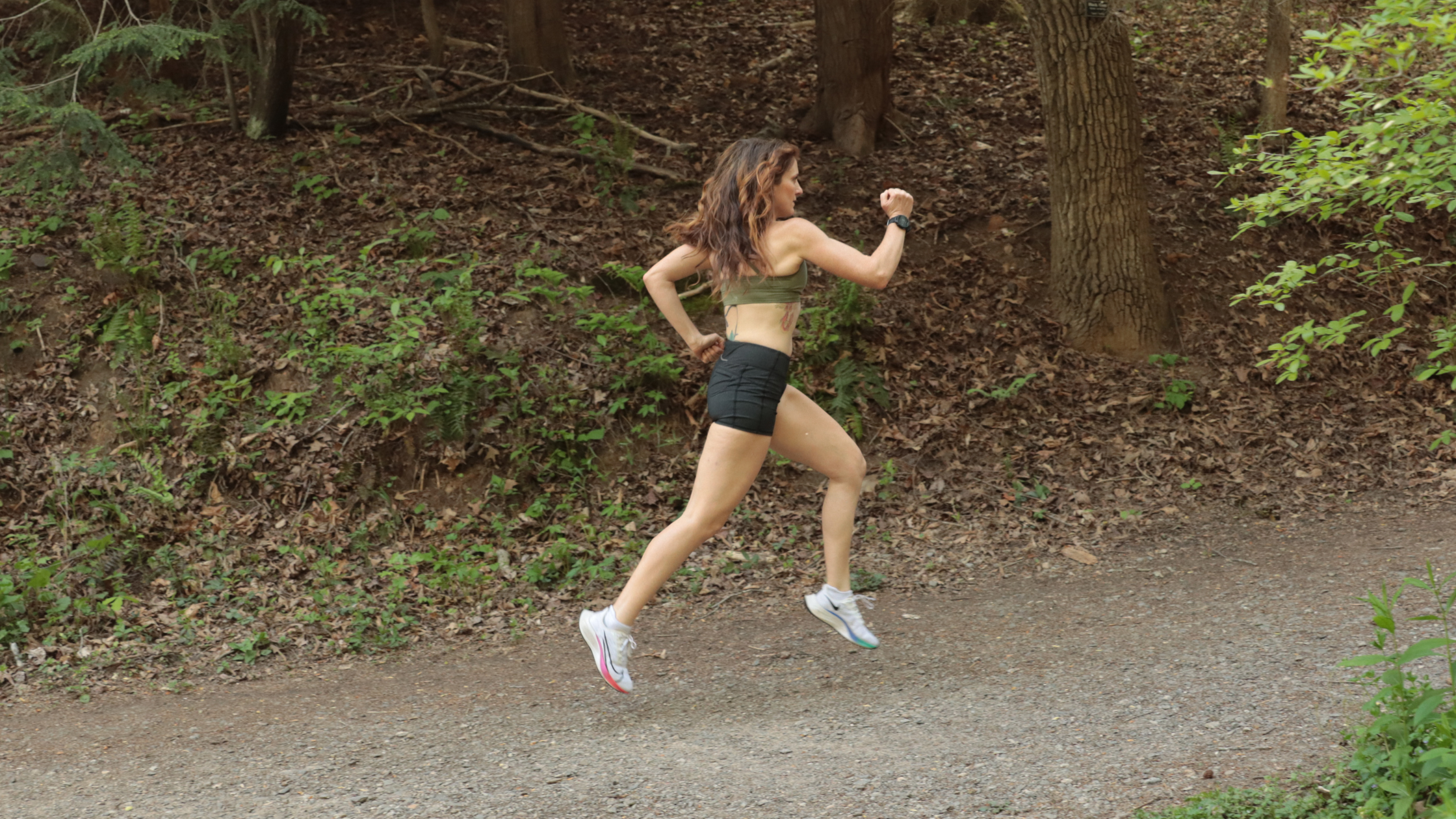Want to build better legs? You know, tough, durable legs that can tackle anything without getting beat up? Sprinkle in some hills. Learn how to run hills right!
Hills are Strength and Speed in Disguise
I live on a ridge in the mountains. So unless I want to run back and forth on the same two mile flat stretch (which I often do), hills are a part of every run.
But I have to be honest. Sometimes, I want to avoid hills. Running is hard enough without being forced to fight gravity! But learning to how to run hills and embrace them can make you a stronger, more durable runner.
That’s because hill running is strength training in disguise. It builds muscle in your calves, quads, hamstrings, and glutes. You’ll also strengthen your hip flexors and Achilles tendons more than you can on perfectly flat ground.
And building strength is just one of the benefits of hills. You’ll also boost your speed, endurance, and perhaps even your confidence if you add some elevation to your runs. Here’s how to run hills right!
How to Run Uphill
The two most important parts of running hills well is great form and great mental attitude. Proper form will help you conquer the hill with less effort, and embracing the hill mentally will enable you to reach the top with far less struggle.
In order to run with great form uphill, it can help to visualize what that looks like first.
Chest Up, Eyes Up
The most important element is learning how to run hills is that you keep your chest up and your shoulders down and back. This allows your lungs to fully expand and take in as much oxygen as possible.
Many times, runners will encounter a hill and will unconsciously hunch forward, unknowingly constricting their airway. Whether this is a physical manifestation of a mental struggle about being forced to work harder or not, crouching forward will make the hill more difficult.
Instead, keep your head and eyes up, looking in front of you instead of looking down. Pretend that you are wearing a name tag on your chest and you want everyone ahead to see it!
Lean From the Ankles
You want to lean into the hill, but not at the waist. It’s better to feel the lean coming from your ankles. If you were to stop and stand still, you should be leaning enough to fall forward.
Drive Arms Back and Knee Up
Your arms should be bent at about 90 degree angles at the elbow. Use the power of your arms to help drive the legs forward, not across the body. After all, what your arms do, your legs will do, so keep them active.
To gain power, drive your knee up and off the hill, not straight ahead into the hill. This is slightly different from a good knee drive on flat ground where the knee tracks straight ahead.
Of course, your power is not actually coming from the knees on hills. Your hips and your glutes are pushing your legs up and forward. I find it helps to think about the working muscles when you are running uphill to make sure those big muscles are doing the work instead of the smaller calf muscles.
Flex the Foot and Big Toe
It is nearly impossible to land on your heel when running up a hill. This is part of why running up hills can be so helpful to improving your form. If you tend to overstride, adding hills to your runs can help you kick the habit.
Your ankles and your feet also get in on the action, springing you up and forward. When you dorsiflex your ankle, or point your toes towards the ground, it helps push you off the ground. Your big toe is the same. Aiming to get the most extension possible from both the ankle and the big toe can make a big difference in how efficient you are with each stride. The more efficient you are, the easier you can run with less energy.
How Downhill Running Builds Better Legs
Now that you know running up hills is good for you, what about the other half, running down hills? Most runners think about the uphill being the hard part. But if you really want to build better legs, working on downhills can be just as beneficial.
Why downhill? Isn’t that the easy part?
The thing that I love most about downhill running is that it’s fun! You can fly down a hill with less effort and at faster speeds than you can on flat land, and it really makes you feel like a little kid without a care in the world. Your lungs do not have to work as hard, and your legs can turn over just about as quickly as they can.
More and more people are seeking out downhill races because they think they will have a better chance of a faster finishing time if they can just fly downhill. While for many people that is the case, for others, a downhill course can absolutely wreck them.
And if you’re a trail runner, hills are just part of the deal. Many trail runners are actually SLOWER on technical downhills because they lack the confidence that rock-solid quads and good technique give you.
There is a technique to running downhill and definitely some things you want to keep in mind about training and racing downhill. If you do it right, you can take advantage of gravity’s free speed, but if you do it wrong, you can send much stronger shock waves up your legs and burn out your quads, risking both performance and injury.
So how do you do it?
Just like when running uphill, you want to have a slight lean forward at the hips to take advantage of the downhill. Don’t overdo the lean; you only need a slight tilt to benefit from gravity.
Now this is going to feel really awkward at first. Our natural human instinct is to lean back into the hill to prevent ourselves from tumbling all the way down and crashing. But what happens when we lean back is that our foot goes forward ahead of us, and often the heel hits the ground first. There’s nothing inherently wrong with heel striking, but if your foot hits the ground before your center of gravity crosses above it, you are adding pounds more stress to your legs. Not only that, but you are braking with every step, giving up the free energy that the downhill is supposed to give you. So you are increasing your chance for injury as well as slowing yourself down at the same time. Not a great idea.
But if you lean down the hill slightly, gravity will pull you forward, so you will have to work less. If you think of downhill running as controlled falling, you can capture that energy and use it for speed. Again, we have an instinct to avoid falling, so this might feel a little strange and even scary on certain hills, but the more you practice it, the better at it you’ll get.
Remember: Lean forward to avoid braking and breaking!
So What Do You Do With Your Arms?
For a road race or another smooth surface, you want to keep your arms relaxed and only slightly moving forward and back. You don’t want to flail them out to the sides because it wastes energy.
On the other hand, for a technical trail race where you are maneuvering over roots and rocks and uneven surfaces, using your arms for balance can be a very good thing. The little energy that it costs to use your arms can be a small investment if it prevents a tumble down the trail.
On the roads where you are not expecting any obstacles, keep your head up and your eyes looking forward instead of down. This is also something that might not feel natural right away, because when we are afraid of falling, we want to look down. Don’t do that. Look ahead to where you are going, not where your feet are.
On trails, of course, you will need to shorten your gaze to avoid obstacles, but you still should be looking several feet ahead of you and not down at your feet.
Getting good at the forward lean takes practice, but eventually you will build confidence. Confidently leaning forward when your instinct is to pull back will not be automatic, so practice it every time you go downhill.
What About Your Feet?
You’ll want to land with your foot right beneath your torso or as close as you can. Depending on the grade of the downhill, you might not quite land underneath your torso, and that’s okay if it’s not too much. In general, the steeper the grade, the more likely your foot is to land out in front.
Again, when you extend your leg too much ahead of the rest of your body, you are more likely to land on your heel, which will act like a braking motion. Focus on landing towards your midfoot to maintain speed while staying in control.
You will notice that your stride length naturally extends when running downhill. However, you should not try to consciously increase your stride length. Let the grade of the hill do this naturally for you.
Aren’t Downhills Bad For My Knees?
Running hard downhill is eccentric muscle training, meaning the work is done as the muscle is lengthening. No other form of running will do this.
Downhill running increases your quadricep and hamstring strength and stiffness, improves running efficiency, and has been shown to reduce delayed-onset muscle syndrome.
And of course, it makes you a better downhill runner!
If you are a healthy runner who introduces downhills gradually and recovers adequately, you are not risking your knees but are, in fact, strengthening them. If you have current or recurring knee issues, be even more gentle with downhills; ultimately, however, the strength gains from downhill running helps support your knees.
Like Everything, Start Gradually
The best way to incorporate hills into your training is to add them into your easy runs once or twice a week. Once you are used to that, you can start adding in hill repeat workouts, both uphill repeats and downhill repeats. These workouts are tough, but they are some of the best leg strengtheners you can do outside the gym!
So while they can be tough, learning how to run hills and embrace them can be the best thing for your runing.

